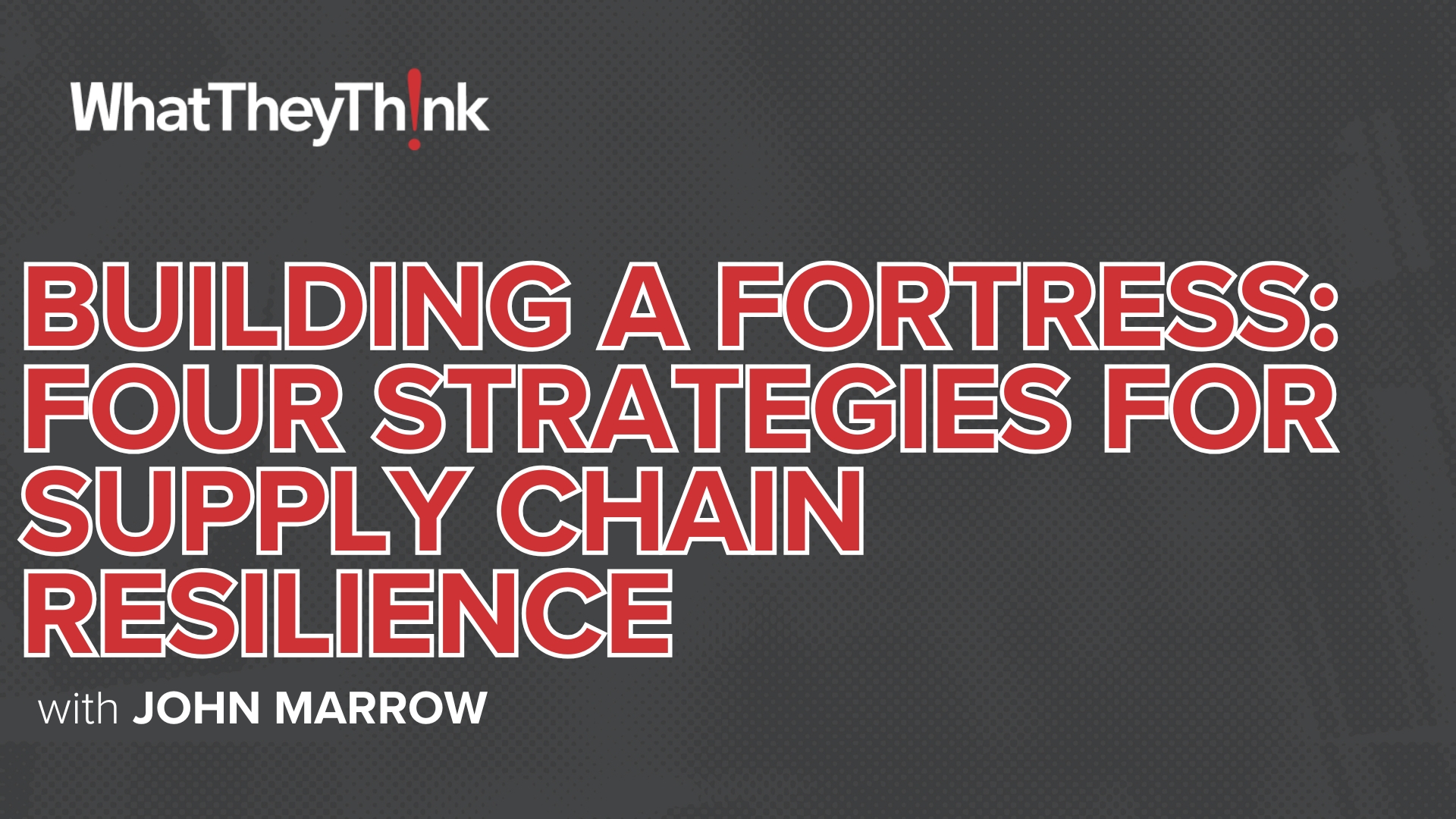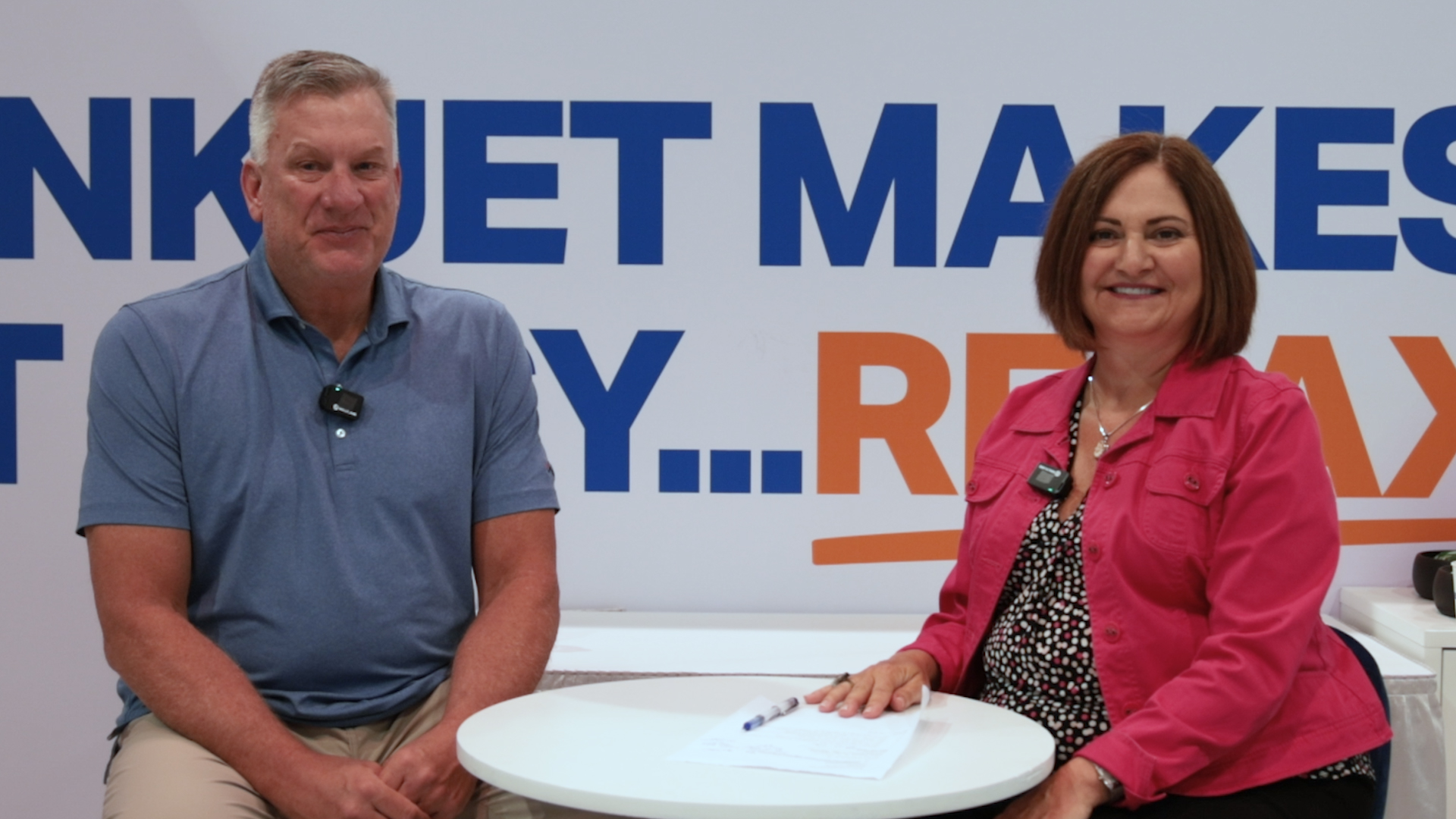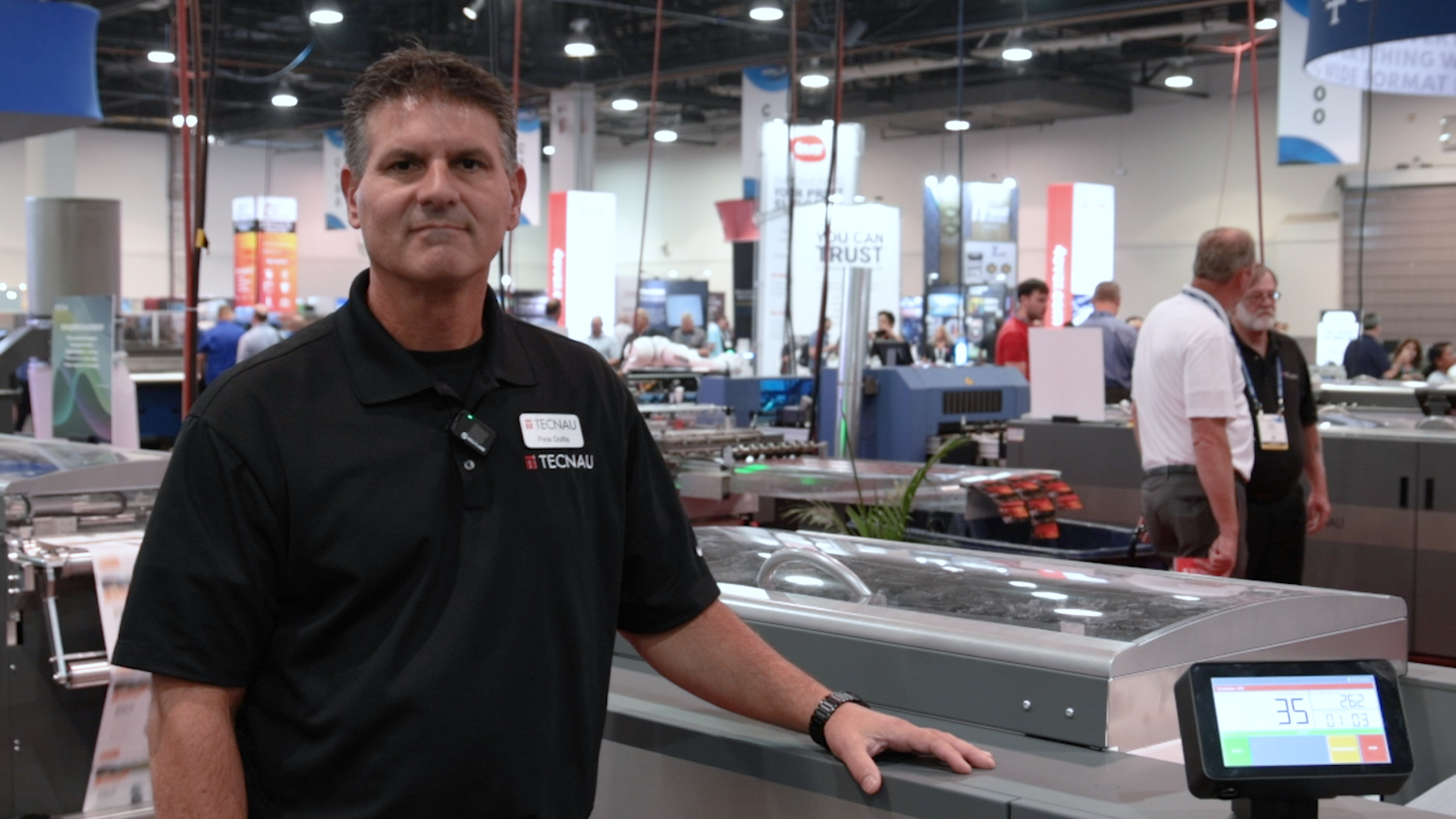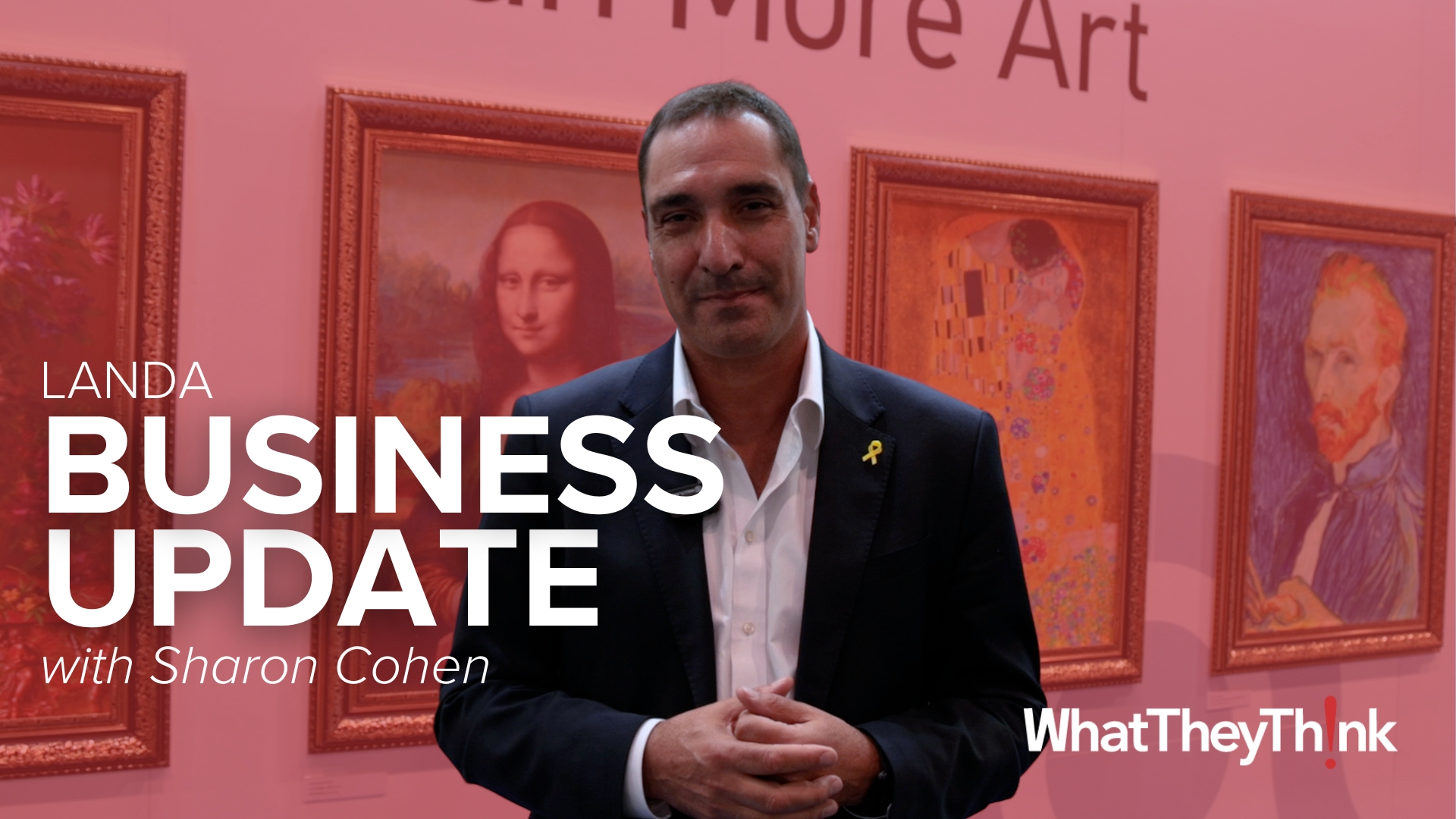Commentary & Analysis
Displaying 900-999 of thousands of articles
Insight You Need. Analysis You Trust.
Get the trusted insights you need to understand our evolving industry and emerging trends. Become a Premium Member.
Overcome the Paper Problem: Three Opportunities for Wide-Format Business Growth in 2023—Plus Four Tips for Success
Over the pandemic, more and more printers expanded into the wide-format space, feeding a high demand for health and safety signage, amidst a growing inability to source paper. Today, you’d be tough-pressed to find a printing company that doesn’t offer some sort of wide-format solution, either in-house or outsourced.
Voice of the Customer: Workflow Automation Driving Inkjet Investments
Three Ricoh customers share their approach for labor challenges by investing in workflow, finishing automation, software integration and faster equipment. Service providers are focused on growing with new inkjet and finishing capabilities to meet customer demands.
The Target Report: Blueprint for Convergence—March 2023 M&A Activity
Crisp Imaging Adds to West Coast Network; and more…
Canon Launches the New Colorado M-Series: Now with White!
Today, Canon is introducing the next-generation Colorado wide-format printer: the M-series. The “M” stands for modular, and among its many other features is that it now supports white ink. Managing editor Richard Romano attended a recent Canon event introducing and demonstrating the new printer line.
Around the Web: Cool Keyboard. Meat Medley. Cuttlefish Camo. Logo Loathing. Logo Listening. Waffle Work. Telekinetic Tech. Peanut Predicament. Diminutive Dryer. Sweet Sweater.
A transparent keyboard with mag-lev keys. Mathematicians have just identified a 13-sided shape that had only existed in theory. Researchers and a printing company form a consortium to develop 3D-bioprinted meat. Scientists use recovered DNA from an extinct species to cultivate a “mammoth meatball.” “Human cells hacked to act like squid skin cells could unlock key to camouflage.” An iconic logo was redesigned and (surprise) the Internet was not happy. The Wikimedia Foundation’s new sound logo is “the sound of all knowledge.” A painting called “Starry Waffles” combines Van Gogh and the Waffle House. Graphene-based brain–machine interfaces let you control things with your mind (bwa-ha-ha!). Peanut butter is apparently a liquid? A new Pop-Tart flavor—and tie-in sweater. All that and more in WhatTheyThink’s weekly miscellany.
Corrugated and Solid Fiber Box Manufacturing Establishments—2010–2020
According to County Business Patterns, in 2020 there were 1,086 establishments in NAICS 322211 (Corrugated and Solid Fiber Box Manufacturing). This category saw a net decrease of 20% since 2010. In macro news, Q4 GDP was revised down.
Designing and Building a Designer Brand Solo: Meet Sarah Thorley and Her Brand Pink Tiger Design
Today we are sharing another “Meet the Designer” story compliments of textiles expert and WhatTheyThink contributor Debbie McKeegan. Sarah Thorley is a recent graduate of Bolton University BA(Hons) Textiles and Surface Design and was recognized in the Green Grads-ECO STORIES Textile Challenge. Learn how Sarah is leveraging technology in developing her product range and how she is learning about commercial life in real time (as a solo designer) in a challenging marketplace with her Pink Tiger Design brand.
Manual Steps are Piling Up in Customer Service
When the power dynamic is uneven across the functional areas of your print business, more powerful areas (production and sales) tend to shift manual steps to the less powerful areas (customer service).
Study: European Consumers’ Attitudes Towards Personalization
Moengage’s “Personalization Pulse Check” (2023) gives us insight into what European consumers think about personalized communications—what they prefer, what they are comfortable with, and what differentiates one brand from another. Stay tuned for pulse checks from other regions, including North America.
Growing Through Difficult Times
Having looked at the labor shortage problem from different perspectives in recent articles, Wayne Lynn gives his thoughts on root causes and how they still impact our companies going forward. The most difficult problem we face may well be trying to grow in the coming decade. Read on and see why Wayne thinks this could be our coming reality.
Product Spotlight: Ultraflex EcoVantage Films
Ultraflex’s EcoVantage line of comprises 100% PVC-free and phthalate-free films for outdoor advertising, POS, wall coverings, and retail displays that are frontlit, backlit, blockout, mesh, indoor, outdoor, and wallcoverings.
Diversification Beyond Signage—The New Challenge for Wide-Format Print in the US
According to the new Smithers report—"The Future of Printed Signage in a Digital World to 2028”— that global value for wide-format and signage applications in 2023 will reach $40.99 billion—down around $5 billion on pre-pandemic value (constant prices). Across the same period the volume of printed signage has fallen, as well. However, the demand for textile and interior design graphics are increasing, providing the main diversification options for wide-format presses.
ISA International Sign Expo Returns to Mandalay Bay with Upcoming Las Vegas Show
For the first time since before the pandemic, the ISA International Sign Expo is heading to its West Coast home at the Mandalay Bay Convention Center in Las Vegas, April 12–14. The Sign Expo is ever-evolving, and this year’s event will boast some new features, as well as some recurring favorites.
The Wild West of Graphene: What’s Real and What’s Not
Graphene was discovered in 2004, has been described as a miracle material, and its discoverers were awarded the Nobel Prize in Physics in 2010 as a completely new material. We’ve written about graphene before, and usually there’s a graphene item in our weekly Friday Around the Web feature. But for more depth, this article reviews a recent study on products claiming graphene content and also encourages materials suppliers and manufacturers to do their due diligence and to seek certification that their materials and/or products actually include graphene. Spoiler alert: 80% of the products tested had no graphene content!
Kicking Off 2023: Best Shipments Since 2020
January 2023 printing shipments came in at $6.67 billion, the best start to a year since 2020.
Around the Web: Period Pause. Element Etymology. Dessert Deposition. Musical Manhole. Garrulous Graphene. Chatbot Chatter. Carbon Carats. Rodent Rack. Arthur Anew. Toy Trouble.
On Monday, March 20, we started a 10-day run of palindrome dates. Who killed the period in the New York Times nameplate? How did the chemical elements get their names? A new printer for 3D-printing chocolate. Scientists 3D-print cheesecake. In Hannover, Germany, a musical manhole cover. A graphene-based artificial throat helps the voice-disabled speak. Two AI chatbots are now citing each other and the results are not positive. Using captured carbon to make diamonds. Scientists grow antlers on mice, for some reason. A new production of “Camelot,” with a book written by Aaron Sorkin. Can you tell the difference between a whiskey bottle and a dog toy? All that and more in WhatTheyThink’s weekly miscellany.
Kyocera Takes the Fast Track to Industrial Print with the Acquisition of NIXKA
Kyocera’s intention is clear: they are moving into the production print industry, and while they may be new to this market, NIXKA isn’t. They actually have 30 years of expertise in developing ink and material jetting solutions, with an impressive track record. This acquisition should help fast track them to their intention.
Digital Textile Printing as a Service: How the Third-Party Print Fulfilment Business Model Is Democratizing the Industry
Digital textile printing has grown more slowly than projected, but an emerging new business model perhaps promises a boost to that growth. In this new model, digital printing as a service, the digital print enterprise offers a managed virtual shop for the designer, where their designs and styles are presented online to the public, but where all the shop functions, comprising order handling, payment processing, digital printing, and drop-ship delivery are handled by the digital printer. Learn more about this trend in this article provided by textiles expert and WhatTheyThink contributor Debbie McKeegan.
Quantum Leaps into Landa
Last week, Morton Grove, Ill.’s Quantum Group and the executive team from Landa Digital held an open house to demonstrate the recently installed Landa Nanographic S10P—and how Quantum Group is starting to shift work from their fleet of digital and offset presses to the S10P.
Beach to Bay Heritage Area Uses Augmented Reality to Tell Its Stories
The Beach to Bay Heritage Area is one of Maryland’s 13 designated historic areas, and has started using AR holotwins to tell the stories of the historic areas promoted and protected by BBHA and to more deeply engage with those who come to visit them.
HP Indigo Doubles Down on Digital Flexible Packaging with the 200K
Now that the market for digital production of flexible packaging is starting to take hold, HP has developed the next generation of product that builds on the expertise gained with the 25K as well as their other products and technologies.
Turnover and Employment in Print in Europe—The Netherlands
This bi-weekly series of short articles aims at shedding a spotlight on the size of the printing industry in Europe per country and how revenues and employment developed in 2020, when the pandemic impacted businesses. This time we look at the Netherlands, the seventh largest printing industry by turnover in Europe.
Why You Need a Website Assessment: Every Page is Your Home Page
Websites are the company face to the world, but they often miss the scrutiny that our workflows get when it comes to efficiency and optimization. Start the year with a plan to assess your website to see if it still meets your needs and works for your visitors.
Around the Web—Folio Fest. Doom Display. Russet Wrap. Graphene Gear. Brick Boon. Face Folly. Enzyme Energy. Goat Gardening. Marenghi Mania. Noodle Napping. Ranch Revulsion.
The 400th anniversary of the publication of Shakespeare’s First Folio. San Francisco’s new “Museum of the Future AI Apocalypse.” Compostable, potato waste-based cling film. Graphene-based sportswear from Umbro. Slack adds ChatGPT because why not? The world’s most disturbing videoconferencing display. Scientists discover how bacteria convert atmospheric hydrogen to energy—a potential new, clean power source. Goats are the secret to combatting California’s wildfires. Celebrating “Garth Marenghi’s Darkplace.” Four words that should never be used together: Hidden Valley Ranch Ice Cream. All that and more in WhatTheyThink’s weekly miscellany.
Paperboard Container Manufacturing Establishments—2010–2020
According to County Business Patterns, in 2020 there were 1,910 establishments in NAICS 32221 (Paperboard Container Manufacturing). This category saw a net decrease of 13% since 2010. In macro news,inflation is sort of moving sideways.
Print: A Surprisingly Effective Way to Engage Younger Consumers
Today’s brands have more ways than ever to connect with and engage their intended audiences. Meanwhile, consumers also have an array of options for staying in touch with their favorite brands. Print may be uniquely positioned to cut through the digital clutter and prompt so-called digital natives to engage and take action. This article explores how generational differences can affect consumers’ preferences when interacting with printed communications.
Stepping Over Dollars to Pick Up Pennies
We tend to discount the time of our full-time employees because we are paying for it already—looking at them like sunk costs. So, when we ask them to do things that are non-value add (aka a complete waste of their time), we don’t see it as a cost. Well, it has real costs.
Do Forest-Growth Numbers Tell the Whole Story?
If the number of trees in the United States is growing, where is this idea coming from that there are not enough trees? Is it possible that certain reforestation data don’t tell the whole story?
Hunkeler Exploring New Post-Processing Markets at Innovationdays
European section editor Ralf Schlözer reports on Hunkeler's finishing solutions launched at this year Innovationdays.
Aptean ERP for Apparel Manufacturing Delivers Key Insights in 2023 Report
The fashion industry is in need of radical transformation in order to reduce its deleterious effect on the environment, including excessive wastewater, carbon emissions, impact on landfills, and more. In this article, we review a recent study produced by Aptean, which approaches the problem from the perspective of the value of an effective, purpose-built ERP, but we also note that the industry must go beyond that with a holistic view of the entire life cycle of its products in order to have any hope at all of meeting aggressive 2030, and even 2050, sustainability goals.
Around the Web: Mail Magazine. Lame Logo. Typing Tome Two. Mining Microbes. Edible NDAs. Tofu Trouble. Kinetic Cake. Rex Renting. Cool Carpet.
Subscription-based digital magazine company Air Mail plans a print edition. The controversy over Nokia’s new logo. More online fun c/o the new book “Shift Happens.” A highly usable E Ink typewriter. Bacteria can absorb rare earth metals, making recovery quick and easy. Edible graphene health monitors. NDAs in pill form that can be ingested after use. A Maine vegan runs into trouble with a misinterpreted license plate. An animated “caketrope.” Rent a dinosaur for your next party. All that and more in WhatTheyThink’s weekly miscellany.
January Production Employment Down
Overall printing employment in January 2023 was down -1.7% from December, due entirely to a -4.2% drop in production employment, as non-production employment was up +4.1%.
Making Your Business Future-Ready
The first principle of managing your human assets (talent) is to put qualified people in jobs they are behaviorally suited to perform. Sounds hard but it’s easier than you might think if you do it the right way. In this article, Wayne Lynn shows how to take the first step in the process of preparing the people side of your business for the future.
Designer Q+A: Meet Estelle Pearce, The Super-Talented Digital Fashion Designer Using Tech to Push the Boundaries of Fashion Design
Leeds Arts University graduate Estelle Pearce, who earned a Masters in Digital Fashion, was selected to showcase her work at Digital Fashion Week New York and London Fashion Week. She works in both physical and digital media and has more than 15 years’ experience in the fashion industry. In this interview, compliments of textiles expert and WhatTheyThink contributor Debbie McKeegan, we learn more about her work and how she utilizes technology to explore her creativity.
ChatGPT Tackles Floor Graphic Research and Case Studies
Continuing WhatTheyThink’s investigation into AI writing assistants, we took another look at ChatGPT’s ability to research industry-relevant topics. This week, we tested its ability to retrieve highly specific information such as research and case studies.
The Target Report: Duking it Out in the Label Business—February 2023 M&A Activity
Resource Label, Brook + Whittle and Inovar Acquire; and more…
Hunkeler Innovationdays: Innovation and Excitement
Hunkeler Innovationdays 2023 was a resounding success for the partners, the attendees, and the industry at large. The theme of the event was Next Level Automation and it was displayed in every solution on display at the event. Importantly, it is also a sign that the industry as a whole is on the right track.
Thinking About Websites: Every Page is Your Home Page
When was the last time you looked at your website? How easy was it to find information? Were the pages formatted consistently. Was the information current? In this missive the focus is on the value of regular reviews of your face to the world. Next time the focus is on how to approach a website assessment project.
Print Turnover and Employment in Europe—Spain
This bi-weekly series of short articles aims at shedding a spotlight on the size of the printing industry in Europe per country and how revenues and employment developed in 2020, when the pandemic impacted businesses. This time we look at Spain, the fifth largest printing industry by turnover in Europe.
DocketManager Aims to Help Customers Spend Time on Profitability: An Interview with Jay Farr
You may remember Jay Farr who founded ePACE in 1985, a mid-range print MIS solution and the first browser-based MIS, that was ultimately acquired by EFI in 2008 (now eProductivity Software). Following his commitments to EFI pursuant to the terms of the acquisition, Jay continued to be a presence in the Print MIS business, and in 2016, became an investor and the VP of Business Development for DocketManager. We recently spoke with Jay to learn more about this unique MIS solution.
Internet Publishing and Broadcasting and Web Search Portal Establishments—2010–2020
According to County Business Patterns, in 2020 there were 8,947 establishments in NAICS 51913 (Internet Publishing and Broadcasting and Web Search Portals). This category saw a net increase of 66% since 2010. In macro news, early forecasts of Q1 GDP are running slightly bearish to slightly bullish.
Around the Web: Defogging Dickens. Device Disorientation. Volcano Volume. Silly Spectacles. Denim Defense. Snow Sobriquet. Fruit Fiasco. Vicious Vehicle. Deafening Duet.
A new London exhibition looks at Charles Dickens’ relationship with fog. Antibacterial graphene-infused socks. Digital natives can have trouble operating office equipment. “The singular natural event that caused the loudest sound in the world.” A history of “Groucho Glasses.” “Air bag jeans” for motorcyclists. The winners of Madison, Wis.’s snowplow naming contest. An airline’s “vegan meal” consists of a single banana. Starbucks is adding olive oil to coffee, for some reason. Ford’s patent for a “repossession system computer” is the dystopian future of driving we don’t need. A duet for piano and car alarm. All that and more in WhatTheyThink’s weekly AI-free miscellany.
Is Print a Commodity?
Most businesses in the printing supply chain want to believe that print is not a commodity, and that print buyers will typically make purchases based on value rather than price. According to recent research of print buyers by Keypoint Intelligence, however, price is indeed a powerful factor that can motivate the print purchasing decision.
Digital Textile Industry Growth Accelerates
After seeming to stall for some time, the digital textile industry is now projected to grow by 14.4% to 2030 according to Grand View Research. In this article, compliments of textiles expert and WhatTheyThink contributor Debbie McKeegan, we recap the research and why it is important to the industry and to the planet. The growth will be driven by the success of web-based on-demand business models—the urgency of the sustainability agenda—and the sheer economic efficiency of digital textile printing, according to the research.
ChatGPT Talks Paper Alternatives
ChatGPT seems to be everywhere these days, and much of the discussion revolves around whether it will replace human writers. Much less discussed is its value for research and idea generation. So WhatTheyThink applied ChatGPT’s capabilities to the paper shortage.
Deciding What’s Important
In a print plant, it is easy to come to work and fall into the drama of getting jobs out the door. There is always something you can focus on in your day-to-day work life. The art of moving your business forward happens when you direct your focus to areas of your business that you can impact the most.
Three Trends in Experiential Design for 2023
Design firm SOSO recently identified three major trends in “experiential design” for 2023. Experiential design is where signage and décor meet, and experiential graphics have been a hot application area for signage and display graphics producers. What are these top trends to keep an eye out for?
Media and Journalism Predictions for 2023
Every year, the Reuters Institute for the Study of Journalism publishes a global report on Journalism, Media, and Technology Trends and Predictions. European section editor Ralf Schlözer culls some implications for the printing and publishing industries.
Fungus Among Us?
How much fungi do you expect to see in your future? There is a tremendous amount of research and development ongoing to develop various forms of fungi—including mushrooms and their “roots,” mycelium—into replacements for everything from meat to leather and more. Read on!
WhatTheyThink Remembers O.Mike Fichera
Orazio “O.Mike” Fichera, founder of Dealer Communicator, passed away on January 17, 2023, at 91. WhatTheyThink contributors remember O.Mike.
Hooray! 2022 Shipments Outpaced 2021
December 2022 printing shipments came in at $6.97 billion, down from November’s $7.10 billion. But January-to-December shipments for 2022 came in at $83.47 billion, an improvement over 2021’s $82.05 billion.
Around the Web: Font Finale. Wide-Format Whiskey. BBall Boon. Fold Fashion. AI Attorneys. Turntable Tech. Obsolete Objects. Disquieting Design. Disturbing Drones. Peep Pop.
Adobe has officially ended support for Type 1 fonts. Order a Jameson Whiskey “Desk Decoy” for St. Patrick’s Day. Wilson creates a 3D-printed basketball that doesn’t need inflating. Uyen Nguyen creates “origami fashion.” London law firm uses AI to answer questions about the law, draft documents, and draft messages to clients. Graphene is used to make turntables. Smithsonian magazine traces the origins of the term “OK.” Consumer items that have become obsolete since the beginning of the 2000s. Deliberately annoying examples of bad industrial design. The Smithsonian and MTV team up for an artist reality competition program, for some reason. Using taxidermied birds as drones. Pepsi and Peeps partner to make Peeps-flavored cola. All that and more in WhatTheyThink’s weekly miscellany.
DTG Printing Machinery SS/2023 Review: Stellar Growth and New Technologies to Explore
Stellar growth in the use of direct-to-garment (DTG) digital textile printing machinery continues to provide a unique and highly successful business model, gaining traction worldwide. As a technology built to deliver speed to market, it’s built for on-demand production and as such sustainable manufacturing—driving down inventory and production costs. In this article, provided by textiles expert and WhatTheyThink contributor Debbie McKeegan, you'll learn not only about DTG opportunities, but also the growing field of direct-to-film for garment printing.
Maximizing the Benefits of Personalized Communications
In the constant battle for consumer attention, marketing managers have a variety of communication options—digital and physical—for reaching their customers. Despite ongoing concerns about data security and privacy, consumers still expect a personalized experience from the firms that they do business with. This article explores how personalized communications can foster loyalty, increase customer engagement, and ultimately deliver the best possible experience.
Competence in Leadership
How to go about developing leaders is not well understood. Yes, there are certain types of knowledge that is needed and relatively easy to come by. There are important skills that help the accomplishment of a leader’s objectives and there are many sources to drawn from to learn them. The right type of experience can play an important role and it’s typically not hard to discern If a developing leader has that or not. Most people, however, are not aware of a number of behavioral competencies that, when mastered, are highly predictive of success in leadership. Wayne Lynn introduces the most important one in this article to illustrate the point.
Survey Results: What Happens When Traditional Paper Stock Is Not Available?
This prolonged period of paper shortage has required patience, persistence, and creativity from both printers and their customers. How is the industry responding? This article looks at the results of WhatTheyThink's survey on what happens when traditional paper stocks are not available.
Three Inkjet Workflow Pain Points and One Answer—Part 1: Labor as Friction, Automation As Lubricant
In this series we look at three of the top inkjet workflow pain points and paths to reducing the friction they cause with one technique that pays off. It starts with data but doesn’t end there. Data requires analysis and interpretation.
Xeikon Extending Its Label Line-Up
Digital label printing has been a growth market for many years, served by a large number of printer suppliers. Xeikon, offering both electrophotographic and inkjet label presses, expands both product lines. European section editor Ralf Schlözer looks at the new units.
Turkey, Textiles, and the Horrific Earthquake
The earthquake in Turkey was a truly devastating event. The death toll is nearing 50,000, a toll that is expected to grow significant over the coming days and weeks, making it the worst disaster in the country’s modern history. The only good news is that, miraculously, rescue teams are still pulling survivors from the rubble, including three that were rescued 11 days after the event, which occurred on February 6. The Istanbul Fashion Connection was scheduled for February 8 to 11 in Istanbul. Hanna Abdulla, News Editor for Just Style, was in the country for the event. We share a few of her insights about how the industry is working to help during this crisis and some background on the textiles industry in Turkey.
Assorted Publishing Establishments—2010–2020
According to County Business Patterns, in 2020 there were 557 establishments in NAICS 511199 (All Other Publishing). This category saw a net decrease of 39% since 2010, , although we’re not talking about a tremendous number of establishments. In macro news, inflation appears to have peaked.
Around the Web: Bing Bungling. Digital Decemberists. Design Deets. Blueprint Bop. Taxi Trial. Arm Addition. Milk Machine. Goat Gala. Air Ale.
Bing’s AI chatbot amuses and terrifies. Band frontman Colin Meloy has ChatGPT write a Decemberists song. Trends in experiential design. A metallic print that maps the history of jazz in the style of a circuit diagram of a 1950s phonograph. Graphene-based water purification. Stay off the sidewalks: robotaxis now approved for on-street use in California. Bill Watterson of Calvin & Hobbes fame has a new project coming out. Researchers are working on giving humans a robotic third arm that can be controlled by the brain. A countertop device for making vegan milk. A Valentine’s Day “goat fashion show” in San Francisco. A San Diego brewery uses the airport’s air conditioner condensation to make beer. All that and more in WhatTheyThink’s weekly miscellany.
Giving Cybersecurity the Attention it Deserves
As they strive to keep pace with today’s customer-centric marketing, many organizations are responsible for protecting a huge quantity of personal and confidential data. Consumers often view sharing their confidential data with businesses as a necessary evil—they want to receive personalized marketing pieces, but they are concerned that their information could be compromised. This article explores why it’s more important than ever to understand cybersecurity and protect consumer data.
Epson And Yuima Nakazato Spotlight New Technology and Circular Fashion at Paris Fashion Week
Japanese designer Yuima Nakazato chose Paris Fashion Week to launch his latest collection. He seeks to deliver garments that enhance the life of the wearer whilst seeking to improve the environmental impact of the fashion Industry and ultimately to democratize couture. His work symbolizes the reform of apparel—where design and materials combine to deliver a biophilic experience, nurturing the body and the planet simultaneously.
This Plant Wouldn’t Run Without Me
In conversations with a label converter recently, the General Manager told me that more than once in the last few years key employees had voiced the core belief that “this plant wouldn’t run without me.” Now, you can take this statement a lot of different ways. My initial reaction is concern for the business because the employee that says this is both likely a key player and potentially a risk.
Commercial Paper Remains Tight, But Things Are Improving for Labels
While paper shortages and associated inflation will continue into 2023, there is good news coming from the label world. While domestic energy, packaging, and freight are not declining, suppliers are starting to see them stabilize and the supply chain ease as a result.
Turnover and Employment in Print in Europe—UK
This bi-weekly series of short articles aims at shedding a spotlight on the size of the printing industry in Europe per country and how revenues and employment developed in 2020, when the pandemic impacted businesses. This time we look at the UK, the second-largest printing industry by turnover in Europe.
New Challenges and Approaches to Packaging Workflows—Part Three
The integration of analog and digital equipment can provide lots of opportunities but also challenges in plant optimization. Workflows, especially front office and plant for packaging operations, have to address many complexities not found in commercial printing workflows.
Can the Fashion Industry Accelerate Climate Action Fast Enough?
As fashion week hits New York’s runways it's a good time to review the state of the industry and its progress...or not...toward a more sustainable future. Here we provide high level results from a research report produced by The Climate Board in partnership with Textile Exchange: “Friction Points in Fashion and Textiles: Removing Barriers and Accelerating Climate Action.”
Women’s Networking Luncheon Kicks Off Annual Event at ePS CONNECT
This year’s CONNECT event, hosted by eProductivity Software at The Wynn in Las Vegas, featured a Women’s Networking Lunch where women—along with some men—gathered to hear the stories of powerful women and discuss ways to get more women into the industry and leadership positions.
Tales from the Database: Software
In our January/February 2023 print edition, we are launching a new series called “Tales from the Database,” drawing on six years’ worth of Print Business Outlook surveys. In every survey, we ask a broad cross-section of print businesses about business conditions, business challenges, new business opportunities, and planned investments. January/February is the software issue, so we rounded up a few software-related challenges, opportunities, and investments to see what the historical data can tell us.
Around the Web: Typing Tome. Typographic Talking. Dated Doodling. E Etiquette. Kayak Composite. Faux Phoning. Dodo De-Extincting. Fatal Philodendron. Carb Crazy.
A comprehensive book about keyboards. “Type empathy.” Researchers explore ancient book doodles. What are the new rules of etiquette, online and off? Graphene is used to make stronger and lighter kayaks. iPhones and “smart” watches are inundating 911 with mistaken emergencies. A company called Colossal Biosciences aims to bring back the dodo à la “Jurassic Park.” A machete-wielding plant. Move over, pastini: three new pasta shapes now available! All that and more in WhatTheyThink’s weekly non-balloon-centric miscellany.
COP Out: COP27 Left More Questions Than Answers
Senior Editor Cary Sherburne reports on the results—such as they were—from the United Nations Framework Convention on Climate Change’s most recent conference, COP27, held in November in Sharm El-Sheikh, Egypt.
Executive Q&A: Nick Benkovich, Vice President Of Product Management at eProductivity Software
WhatTheyThink talks to eProductivity Software’s Nick Benkovich about how print businesses’ software needs are changing in response to changing customer needs.
Going for the Gold: Pro Tips to Get the Most Out of Your Digital Embellishment Production
Taktiful’s Kevin Abergel talks to three experienced digital embellishment producers about how they get the best results from different papers, laminates, and foils and how they feed that knowledge back to their customers.
Keep the Napkin: What Started as a Small Idea Turned into a Multimillion-Dollar Company
Software is the future of every printing business. At More Vang, it’s the present. More Vang president Jon Budington explains how More Vang went from commercial printer to software developer.
Taking the Lead: Textiles Thought Leaders Are Lighting the Way to a More Sustainable Industry
The textiles and apparel industry overall has seemingly made little progress toward stated sustainability goals, but there are bright spots that light the way to a more sustainable future for the industry. In researching this article, we spoke with three thought leaders in the industry who we hope will act as an inspiration to others, accelerating the industry transformation that must ultimately occur, including Adobe, Raspberry Creek Fabrics and Spoonflower.
The Target Report: The Box is Back—January 2023 M&A Activity
Italy-Based Pusterla Acquires Two US Box Makers, Supremex Executes Box Strategy; and more…
Making the Connection: Software Connects the Dots for a Display Graphics Provider
What do we talk about when we talk about “software” in the context of display graphics production? When it comes to print production, and especially “workflow automation,” what we’re usually talking about is “RIP and print” software—and getting this software to talk to all the other software in the shop.
Working Over Your Workflow: 5 Steps to Turn Your Digital Printing Workflow into a Profit Maximizer
Reviewing your workflow on a regular cadence can lead to continuous improvement. It can also lead to continuous savings! With every new software tool and every new device there will be opportunities for more efficiency and optimization. Here is how to build your profit maximizer.
Small Business’ Growing Investment in DIY Marketing Software Creates Opportunities for Savvy Printers
Increasing numbers of small and mid-sized businesses are investing in DIY marketing automation. Platforms such as MailChimp, Pardot, and HubSpot lower the barrier to entry, but without the marketing and database expertise to put them to use, those tools are little more than window dressing. Heidi Tolliver-Walker explains how understanding where and how to plug in can be of significant value to those customers.
Off-the-Shelf Software Is No Solution: How to Customize a Software Solution That Solves Your Workflow Needs
With the shifting market directions of procurement and print production there is a lot to be learned about the new requirements, processes, and pain points of the customer base. Building a “one size fits all” solution will usually fall short of those goals. Ultimately the solution needs to fit the specific needs of a PSP and their customer and partner relationships.
Stop Buying Sticky Notes: Print Software Providers Are Developing Software to Evolve with Your Company
Senior Editor Cary Sherburne looks at how print software solution providers are responding to the evolving needs of customers.
Graphic Arts Employment Flat or Declining in December
Overall printing employment was essentially flat in December 2022, being down -0.1% from November, and essentially unchanged from December 2021. Production employment was up +0.4% while non-production employment was down -1.1% from November.
Around the Web: Type Tropes. Found Font. Box Boom. Synthetic Sermon. Moon Minutes. Time Trouble. Sinkhole Signage. Dip Dissed. Fowl Felon.
Monotype released its 2023 Type Trends Report. The mystery of Frank Herbert’s “Dune” typography revealed. The growth in demand for…newspaper boxes? A rabbi delivers a sermon written by ChatGPT. A visual game in which you are shown a photograph and have to identify what year it’s from. What time is it on the Moon? Rolex is suing a maker of children’s clocks. You might want to pay attention to “Road Closed” signs. Trader Joe’s announces its (controversial) Customer Choice Awards. A former Chicago area school district official allegedly stole more than $1 million worth of chicken wings. All that and more in WhatTheyThink’s weekly miscellany.
Green Printing to Drive Future Innovation in Equipment and Inks, Says Smithers
Sustainability in printing is an increasing priority across the world, with print buyers paying more attention to the carbon impact of all their business activities. This can provide a demonstrable commercial advantage for those print systems and operations that give a genuine reduction in environmental impact. In this article, Smithers shares its latest insights into the short- and medium-term impact of the drive to greener printing.
Printing Outlook 2023—Back In Black
Digging into the results of our Fall 2022 Business Outlook Survey for the our annual Printing Outlook 2023 report, they showed an industry that is indeed “back in the black.” However, new challenges other than the pandemic plagued print businesses in 2022, and while many of them are easing as we head into 2023, new challenges are on the horizon.
The Competent Business
It has never been harder to survive and thrive in the graphics industry. Increasingly, the bar is rising on what is required of owners, CEOs, and employees. Are you thinking about how to improve the overall competence of yourself and your people?
The Labor Challenge of Print Software Expertise
Printers are complaining of the lack of qualified candidates and a higher-than-expected amount of turnover. While this section of WhatTheyThink is titled Software, the focus is often more on people than software. After all, people are what make your software investments' ROI. Software is simply potential.
What Are You Telling Your Customers About the Paper Shortage?
The height of the pandemic is behind us. The supply chain is moving again. Why are paper prices still so high and paper still in short supply? How do you explain it to your customers?
Who Manages Print Industry Standards?
We are starting the year with standards to embrace a year of optimization, automation, and growth. The focus this time is on the groups that help us manage the standards. These are the groups to watch because they are managing the processes that lead to changes in existing standards as well as new standards.
New Challenges and Approaches to Packaging Workflows—Part Two
More printing companies are finding opportunities in packaging production as more targeted and shorter packaging production runs increase and new digital tools help reduce the skill sets required. However, many are finding that different production tools and workflows as well as new processes are required to optimize and succeed.
Nearshoring, Reshoring, Onshoring and New Shoring: The Face of Made in America Is Changing
The U.S., for several years, has been trying to bring back manufacturing across the board, including textiles and apparel. The pandemic and the resulting supply chain crisis spurred more action toward this goal. But simply bringing back manufacturing and doing the same old things, only here in America, I don’t believe plays into the American ingenuity theme. That’s where new shoring comes in. Yes, bring back manufacturing. But do it in a way that is innovative, automated, sustainable, and yet competitive. For more details about new shoring, there is an excellent article available on “The Sourcing Journal” (subscription may be required).
Around the Web: Map Mania. Wrapped Ride. Bot Bill. Nullifying Knitwear. Calamity Clock. Core Conundrum. Scent Sensors. Wall Wings. Phishing Fish. Soda Sauce.
Sales of paper maps are soaring. Snoop Dogg’s adventures in vehicle wrapping. Massachusetts legislators use ChatGPT to write a bill…regulating ChatGPT. Wearing an ugly sweater can make you invisible to AI, if no one else. Scientists change the Doomsday Clock to 90 seconds to midnight. If it’s not one thing it’s another: now the Earth’s core has stopped spinning. Graphene-based sensors function like “electronic noses.” A Reddit embroidery forum 2022 award goes to embroidered chicken wing wall art. A bunch of aquarium fish pull off a credit card scam (not The Onion). Mountain Dew releases a hot sauce. All that and more in WhatTheyThink’s weekly miscellany.
Greeting Card Publishing Establishments—2010–2020
According to County Business Patterns, in 2020 there were 107 establishments in NAICS 511191 (Greeting Card Publishing). Although this represents a net increase of 4% since 2010, it has been a category that has ebbed and flowed over the course of the decade, although we’re not talking about a tremendous number of establishments. In macro news, real GDP increased 2.9% annualized in Q4.
The Lasting Appeal of Physical Mail
Today’s customers have more options than ever when deciding how to interact with their transactional communications (i.e., bills and statements). Printed mail is no longer the only way to receive bills and statements, but many consumers still recognize and appreciate print’s value. This article cites recent research to highlight the importance of physical mail.
Texintel Live Interview with EFI Reggiani’s Adele Genoni
This video interview, conducted by and provided compliments of textiles expert and WhatTheyThink contributor Debbie McKeegan, discusses digital textile printing with Adele Genoni, senior vice president and general manager of EFI Reggiani. They discuss new printing technologies and Adele shares her insights on industry trends and how EFI Reggiani technology is evolving to fulfil market demands.
Where Are Marketing Budgets Increasing and Decreasing in 2023?
Where are marketers’ budgets increasing and decreasing in 2023? Two studies, R. R. Donnelley’s “Optichannel Opportunity Report” and Neil Patel’s “How Marketers Are Spending Their Money” paint a consistent picture. The money is going where the proof of ROI is.
Legendary Game-Saver Becomes a Game-Changer for Print Industry Recruitment
Expert training, hands-on experience, professional certification, and supportive mentoring: all of these advantages await the young people taking part in a unique partnership for workforce development between the printing industry and a leading charitable institution.
New Challenges and Approaches to Packaging Workflows—Part One
Since there is an increasing shift of consumers from large global brands to smaller local/regional brands, so is the amount of disparate packaging required. However, while the diversity of needs commercial print are feeling the pressures, packaging adds many other level of complexities.
Turnover and Employment in Print in Europe—France
This bi-weekly series of short articles aims at shedding a spotlight on the size of the printing industry in Europe per country and how revenues and employment developed in 2020, when the pandemic impacted the businesses. This time we look at France, the fourth-largest printing industry by turnover in Europe.
- Questions to ask about inkjet for corrugated packaging
- Can Chinese OEMs challenge Western manufacturers?
- The #1 Question When Selling Inkjet
- Integrator perspective on Konica Minolta printheads
- Surfing the Waves of Inkjet
- Kyocera Nixka talks inkjet integration trends
- B2B Customer Tours
- Keeping Inkjet Tickled Pink
© 2024 WhatTheyThink. All Rights Reserved.














